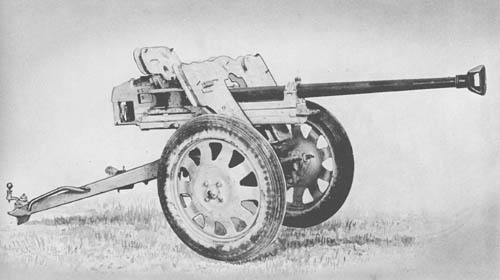
The German antitank gun, Pz. B. 41, captured in the vicinity of Halfaya Pass during the Libyan campaign in 1941, is the first tapered-bore weapon to be found in combat use. Served by a five-man crew, it is normally towed on a trailer, but can be broken down into five loads and transported on a truck or in an airplane.
The tube, which is of heavy monobloc or cold worked construction, is modeled on the Gerlich principle—that is, it is tapered from 28 mm at the breech to 20 mm at the muzzle in order to increase the velocity. No provision is made for cooling the barrel, which is good for about 400 rounds. The forward end of the tube has a muzzle brake threaded to it; the back is attached to the breech ring by an interrupted screw arrangement.
The firing mechanism, of the inertia type, consists of the firing-pin, firing-pin guide, spring and retainer. A breechblock of the horizontal sliding block type is actuated, after cocking, by an operating handle attached to the top of the breech ring.
Both the carriage and pedestal are of welded construction. Shields fixed to the carriage by metal hooks and spring plungers are constructed of steel plates about 3/8 inch thick. Detachable trunnions for fastening the gun and recoil mechanisms to the pedestal permit quick assembly and breakdown of the piece.
The wheels are of the perforated disk type and have pneumatic tires mounted on them. These tires, which are probably Lynthetic, have no valve stems, indicating that they are filled with a cushioning material.
The trails are of the split type and can be locked together or spread at an angle of about 45°.
The gun is flexible on its mount, and as no elevating or traversing gears are employed, these operations are most likely manual. A straight tube telescope is used.
SPECIFICATIONS
| Caliber | 28 mm at breech 20 mm at muzzle |
|||||||||||||||||||||||||||||||||||||
| Weight (complete) | 491 lb. | |||||||||||||||||||||||||||||||||||||
| (tube) | 76 lb. | |||||||||||||||||||||||||||||||||||||
| (barrel & brake) | 80 lb. | |||||||||||||||||||||||||||||||||||||
| Length of barrel | 61.36 ins. | |||||||||||||||||||||||||||||||||||||
| Breech mechanism | Horizontal sliding block | |||||||||||||||||||||||||||||||||||||
| Firing mechanism | Inertia type | |||||||||||||||||||||||||||||||||||||
| Recoil mechanism | Hydro-spring | |||||||||||||||||||||||||||||||||||||
| Normal recoil | 9.34 ins. | |||||||||||||||||||||||||||||||||||||
| Rate of fire | 8 to 10 rds./min. | |||||||||||||||||||||||||||||||||||||
| Muzzle velocity | 4,550 f/s | |||||||||||||||||||||||||||||||||||||
| Range (effective) | 500 yds. | |||||||||||||||||||||||||||||||||||||
| Ammunition | A.P. (9,754.4 grs.) | |||||||||||||||||||||||||||||||||||||
| Peneration | ||||||||||||||||||||||||||||||||||||||
|
||||||||||||||||||||||||||||||||||||||
German: p. 131